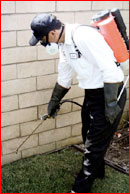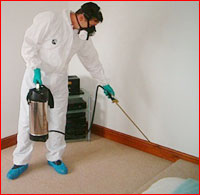Pests can cause enormous damage to library materials.
Insects
Insects pose a serious threat to collections of all types. The environment that is the most damaging to collections—high humidity, poor air circulation, poor housekeeping—is the most beneficial to insects. Libraries and archives can provide insects with food, water, and shelter if the building is accessible and conditions welcoming. If insect damage is evident in a library collection, a careful survey should be conducted using sticky traps to see what types of insects are causing the problem.
Various methods have been used to eradicate pests, with differing degrees of success. These include ethylene oxide (ETO), methyl bromide, formaldehyde, and, more recently, gamma radiation. Most chemical fumigants require that the materials be enclosed, a vacuum chamber in the case of ETO and plastic sheeting or tarpaulins in other cases. Gamma radiation, used to deal with both insect and mold infestations, has the advantage of no residual effects—a major disadvantage with chemicals—but studies have demonstrated that gamma rays damage cellulose, the building blocks of paper. More recently, tests have shown the advantage of both cold and heat to kill harmful insects. Temperature manipulation is preferred to toxic chemicals.
radiation, used to deal with both insect and mold infestations, has the advantage of no residual effects—a major disadvantage with chemicals—but studies have demonstrated that gamma rays damage cellulose, the building blocks of paper. More recently, tests have shown the advantage of both cold and heat to kill harmful insects. Temperature manipulation is preferred to toxic chemicals.
Make the building inhospitable from the outside
The building itself can be made inhospitable to insects. The following sensible precautions can be taken to reduce and control insect populations:
Do not plant shrubs or trees close to a building, and avoid flowering species.
Remove vines, ivy, and other climbing plants from the walls or roof.
Use a wide gravel or paving surround to the building, ensuring that there are adequate and effective drains to prevent water from entering the structure.
Do not attach lights to buildings, as they will attract flying insects. Insects tend to be attracted by ultraviolet, so lights close to a building should have low ultraviolet output. Lights mounted away from the building should be the mercury-vapor type with a high ultraviolet output.
All garbage and rubbish, including garden and library waste, should be kept in a vermin-proof container away from the building.
Ensure that all roof drains and downspouts are kept clear of debris and in good condition.
Bird and other animal nests should be removed from the building.
Seal all unnecessary holes in the building, and seal and caulk around holes for electrical cables, water pipes, telephone connections, and waste pipes.
Doors and windows should be tight fitting and kept closed at all times, and insect screening of an appropriate small mesh size should cover every opening.
When designing a new building, consider the installation of a revolving door.
Making the building inhospitable from the inside
You can also deter the entrance of insects by using solid, impermeable construction materials such as brick, stone, concrete, and steel. If possible, observe these additional steps:
HVAC systems create wet and moist areas, and central systems have condensate drains. HVAC should be located in a basement area rather than on the roof, and steps should be taken to ensure that there is no standing water and that condensate drains are always clear.
Restrooms, janitors’ closets, and workrooms are sources of water and should be segregated from collection areas.
Condensation on cold water pipes can be avoided by wrapping them with an insulation material.
A quarantine room for the inspection of newly acquired material should be established as close to the goods entrance/loading dock as possible. If incoming materials appear to have some form of insect damage, they should be covered tightly with plastic sheeting and insect sticky traps should be placed under the plastic to check for  possible infestation.
possible infestation.
The building interior should be well maintained and kept clean, as free as possible of the dirt and dust that provide nutrients for insects. Water spills should be immediately mopped up, and care must be taken when washing windows and floors that excess water does not permeate the structure through cracks in the walls or floor.
Keep food consumption and preparation areas away from collection areas—ideally in a separate building. It is preferable that food and drink not be consumed in reader and staff areas, although this is often difficult to control. Spills and food debris should be carefully removed and waste receptacles emptied regularly. Receptions and events involving food and drink should not be held in a reading room or adjacent to a collection area.
Refrigerators and appliances that combine heat and moisture are popular habitats for insects. Areas under and around appliances should be regularly cleaned, and sticky traps placed if necessary.
Inside fittings
If insects have secured a foothold within the building, you can impede their mobility by securing inside doors, especially those leading to areas such as a kitchen or restroom. Consideration might be given to fitting these doors with a weather seal. Other steps to take:
• Cracks in inner walls or the floor should be filled to prevent insects from entering and infesting cavity areas.
• Exhibit cases and special storage cases should be fitted with gaskets to ensure tight-fitting seals.
• Fittings, cases, and room corners should be regularly vacuumed and the vacuum bags checked for insects. Filled vacuum bags should be disposed of outside the building immediately after removal.
Killing insects
A freezer set at or below -20° C (-3° F) can be used to kill insects, which should be exposed for three to four days. Books should be placed in plastic bags and, on removal from the freezer, conditioned under a constant air current from a fan. Freezing is best for occasional infestations, not for routine treatment. A simple chest freezer can be used.
Heat can also be used to kill insects in infested materials. Temperatures of 50°C (120°F) will dry out insect bodies. In tropical areas, infested books can be placed in a metal container wrapped in black plastic and left in direct sunlight for a few hours.
Because of the possible health risks, insecticides should be used with great care and with full knowledge of the effects on humans and library materials.
Research is being conducted on safe and natural insect repellents, such as compounds made from Neem, which will help to render collections safe. Combined with freezing and heat treatment for small infestations, natural repellents can  help to control insects while maintaining an environment safe for humans.
help to control insects while maintaining an environment safe for humans.
Harmful insects
There are numerous insect types that can be damaging to library and archive materials, and most are found all over the world. Only a few species can be described here, but the discussion can be extrapolated to cover others.
Cockroaches
These insects seem to be found in every part of the world, and they are tenacious. There are 3,500 types of cockroaches, and they can be divided roughly into urban types, that live exclusively indoors, and outdoor types, that breed and survive outdoors in tropical regions, but which often move indoors when conditions are favorable. The four types associated with damage to library materials: the American cockroach, the Australian cockroach, the Oriental cockroach, and the German cockroach. All four species have large mouth parts and a fondness for starch, thus book cloth and paper are especially vulnerable. Cockroach damage can be recognized by multiple light patches on book cloth surfaces—sometimes down to the thread—and ragged edges on paper leaves. Cockroach droppings can also be detected in the feeding area in the form of pellets.
Pest Control
 Comments:
Comments:








